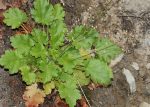 Also called small-flowered alumroot, this evergreen herbaceous perennial is a member of the saxifrage family, Saxifragaceae, that also includes astilbe, tiarella, and bergenia. It is native to western North America from British Columbia to central California where it grows on rocky slopes and cliffs. Plants form a basal mound 12-30″ tall of 2-4″ long gray-green, maple-like leaves that have 5-7 shallow lobes and may be coated with glandular hairs. The leaves are carried on long petioles dotted with glands and often have reddish-green or purple-green color. From late spring to mid summer 1/4″ greenish white flowers in loose open clusters on slender wiry stems up to 30″ long and well above the foliage. The petals are twice as long as the green to purple-tinged calyx and surround a cluster of protruding stamens and stigma. The most popular selection is ‘Palace Purple’ with purple-brown foliage. The genus name, Heuchera, honors Johann Heinrich von Heucher (1677-1747) a botanist, physician, and medicinal plant expert at Wittenberg University, Germany. The specific epithet, micrantha, comes from the Greek words mikros meaning small, and anthos meaning flower.
Also called small-flowered alumroot, this evergreen herbaceous perennial is a member of the saxifrage family, Saxifragaceae, that also includes astilbe, tiarella, and bergenia. It is native to western North America from British Columbia to central California where it grows on rocky slopes and cliffs. Plants form a basal mound 12-30″ tall of 2-4″ long gray-green, maple-like leaves that have 5-7 shallow lobes and may be coated with glandular hairs. The leaves are carried on long petioles dotted with glands and often have reddish-green or purple-green color. From late spring to mid summer 1/4″ greenish white flowers in loose open clusters on slender wiry stems up to 30″ long and well above the foliage. The petals are twice as long as the green to purple-tinged calyx and surround a cluster of protruding stamens and stigma. The most popular selection is ‘Palace Purple’ with purple-brown foliage. The genus name, Heuchera, honors Johann Heinrich von Heucher (1677-1747) a botanist, physician, and medicinal plant expert at Wittenberg University, Germany. The specific epithet, micrantha, comes from the Greek words mikros meaning small, and anthos meaning flower.
Type: Evergreen herbaceous perennial
Bloom: Tiny greenish white flowers on long wiry stems with petals twice as long as the calyx; from late spring to mid summer
Size: 1-2′.5″ H x 1-1.5″ W
Light: Partial shade
Soil:Average, medium moist, well-drained; drought tolerant when established
Hardiness: Zones 4-8
Care: Deadhead to prolong bloom; mulch in winter to avoid heaving; divide when crown becomes woody or every 4-5 years to maintain vigor.
Pests and Diseases: None of significance
Propagation: Seed, division in fall
Companion Plants: Lady’s mantle, ajuga, garden phlox, hosta, fan columbine, astilbe, wild ginger

Outstanding Selections: ‘Palace Purple” (purple brown leaves but intensity is very variable and plants may become somewhat green in summer)
Photo Credits: Wikimedia Commons